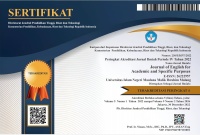PROMOTING WILLINGNESS TO COMMUNICATE IN IMPROVING STUDENTS’ SECOND LANGUAGE ACQUISITION THROUGH LIVEWORKSHEETS.COM
Abstract
This research investigates on the use of online platform media learning, namely liveworksheets.com to facilitate students’ willingness to communicate and acquire their second language in an online classroom. This study is considered essential to be taken account to, as it correlates to the current situation, in which classes are conducted online. To gain the data, questionnaire were distributed to third semester students who are learning English as part of their course for a foreign and second language in Universitas Islam Negeri Maulana Malik Ibrahim Malang. By applying a mixed-method research design, the result of the study presents that there were four main factors affecting students’ willingness to communicate when using liveworksheets.com. This includes learners’ behavioral intention, interlocutors, motivations and their affective-cognitive skills. Moreover, it was also noted that liveworksheets.com was found to be quite beneficial in facilitating students to acquire their second language through the mentioned aspects. Hopefully, the result of the study may bring new insight and contribute to the online teaching learning process that takes place nowadays both for teachers and second language learners.
Full Text:
PDFReferences
Bukhari, S.F., Cheng, X., and Khan, S.A. (2015). Willingness to Communicate in English as a Second Language: A Case Study of Pakistani Undergraduates. Journal of Education and Practice, 6(29). https://files.eric.ed.gov/fulltext/EJ1081256.pdf
Canale, M., & Swain M. (1980). Theoretical based of communicative approaches to second language teaching and testing. Applied Linguistics, 1(1) 1-47.
Cao, Y. K. (2014). A Sociocognitive Perspective on Second Language Classroom Willingness to Communicate. TESOL Quarterly, 48(4), 789-814. DOI:10.1002/tesq.155
Ghanbarpour, M. (2016). Willingness to communicate, linguistic self-confidence, and language- use anxiety: The iranian EFL context. Theory and Practice in Language Studies, 6(12), 2265. DOI:10.17507/tpls.0612.05
Ghani, M., & Azhar, S. W. (2017). Effect of motivation, willingness to communicate (WTC), self perceived communicative competence (SPCC) and L2 anxiety on the frequency of use of english as L2. Journal of Educational Research, 20(1), 157.
Holliday, A. (2015). Qualitative research and analysis. In Paltridge, B &Phakiti, A. (Eds). Research method in applied linguistics (pp.49-62). London, UK: Bloomsbury.
Ivankova, N.V., Greer, J.L. (2015). Mixed methods research and analysis. In Paltridge, B., & Phakiti, A. (Eds). Research method in applied linguistics (pp.63-82). London, UK: Bloomsbury.
MacIntyre, P. D., Clément, R., Dörnyei, Z., & Noels, K. A. (1998). Conceptualizing willingness to communicate in a L2: A situational model of L2 confidence and affiliation. The Modern Language Journal, 82(4), 545-562. DOI:10.1111/j.1540-4781.1998.tb05543.x
Pawlak, M., & Mystkowska-Wiertelak, A. (2015). Investigating the dynamic nature of L2 willingness to communicate. System, 50, 1-9. DOI:10.1016/j.system.2015.02.001
Phakiti, A. (2015). Quantitative research and analysis. In Paltridge, B., & Phakiti, A.(Eds). Research method in applied linguistics (pp.28-48). London, UK: Bloomsbury.
Pramita, G.A.P. (2012). The Contribution of Self-esteem and Language Learning Strategies to the Students’ English Proficiency for Second Year Students of SMA Negeri 7 Denpasar. Published article. Buleleng: Universitas Pendidikan Ganesha. https://media.neliti.com/media/publications/206823-none.pdf
Tavakoli, E., & Davoudi, M. (2017). Willingness to communicate orally: The case of iranian EFL learners. Journal of Psycholinguistic Research, 46(6), 1509-1527. DOI:10.1007/s10936-017-9504-0
Ulin, S. (2020). The Link between Personality Types and Reading Comprehension Achievement of the Eleventh Grade Senior High School Students. Jurnal Pendidikan dan Pengajaran, 7(1). http://jurnal.radenfatah.ac.id/index.php/edukasi/article/download/5698/3057/
Saito, K. (2007). The Influence of Explicit Phonetic Instruction on Pronunciation in EFL Settings: The Case of English Vowels and Japanese Learners of English. The Linguistics Journal, 3(3), 16-40.
Wood, D. (2016). Willingness to Communicate and Second Language Speech Fluency: An Idiodynamic Investigation. System, 60, 11-28. DOI:10.1016/j.system.2016.05.003
Yashima, T. (2002). Willingness to Communicate in a Second Language: The Japanese EFL Context. Modern Language Journal, 86(1), 54-66. https://www.researchgate.net/publication/227534388_Willingness_to_Communicate_in_a_Second_Language_The_Japanese_EFL_Context
Zarrinabadi, N., & Tanbakooei, N. (2016). Willingness to communicate: Rise, development, and some future directions: Willingness to communicate. Language and Linguistics Compass, 10(1), 30-45. DOI:10.1111/lnc3.1217
DOI: https://doi.org/10.18860/jeasp.v4i1.12616
Refbacks
- There are currently no refbacks.

This work is licensed under a Creative Commons Attribution-ShareAlike 4.0 International License.






Editorial Office:
Pusat Pengembangan Bahasa
Program Khusus Pengembangan Bahasa Inggris (PKPBI)
Universitas Islam Negeri Maulana Malik Ibrahim Malang
Gedung C lantai 1
Jl. Gajayana No 50 Kota Malang, Jawa Timur, Indonesia
Kode Pos 65144, Telp/Fax : (0341) 570872
Email: jeasp@uin-malang.ac.id
JEASP : Journal of English for Academic and Specific Purposes is licensed under a Creative Commons Attribution-ShareAlike 4.0 International












